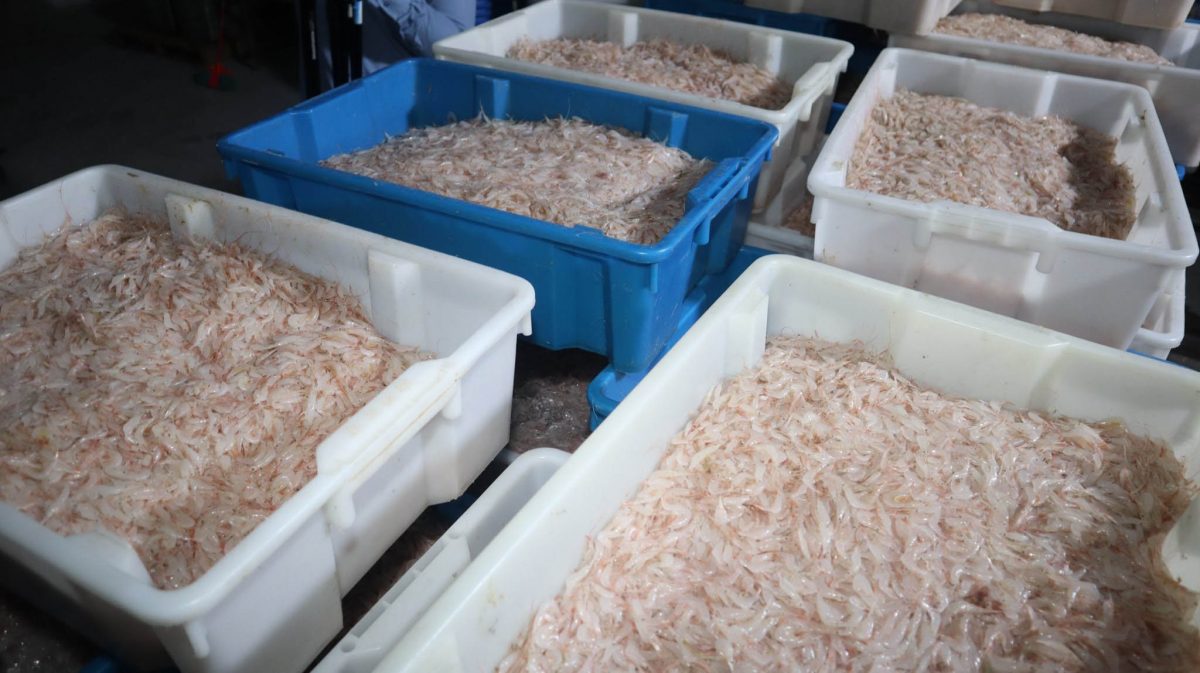A huge Chinese processing plant that was commissioned here recently can utilise up to 40 tonnes of shrimp and 30 tonnes of fish daily.
This is according to Chief Fisheries Officer Denzil Roberts who responded yesterday to questions from Stabroek News.
The huge numbers will add to the growing concerns that this plant could trigger overfishing in the already stressed fishing grounds in Guyana’s waters. Furthermore, the large catches diverted to the processing plant for export to China will likely result in shortages of seafood here and higher prices.
The Ministry of Agriculture announced the opening of the plant operated by Grandeast Inc a wholly-owned subsidiary of Fuz-hou Hongpu Aquatic Products Co., Ltd. in Fujian, China last week.
A release explained that the company is already processing large amounts of shrimp. The amount according to Roberts equates to 40 tons/36 tonnes of shrimp and 30 tons/ 27 tonnes of fish daily.
This amount equals more than half of the 55 ton/50 tonnes of shrimp harvested daily in 2019.
Meanwhile, the World Wildlife Fund (WWF) is still to receive an acknowledgement of a letter written to Minister of Agriculture , Zulfikar Mustapha in December expressing concern that the approval of two trawler licences for the Atlantic seabob trade could lead to overfishing, the loss of trade certification and collapse of the industry.
“It is unfortunate that the letter made it into the public domain but that aside we have not received a response and are awaiting government’s next move,” WWF Public Relations Officer Kempton Daly told Stabroek News yesterday.
He related that it is his organization’s preference to work with government and other concerned parties through the fisheries working group.
Asked if the group had discussed the opening of the large Chinese-owned seafood plant or if his organization had been informed at all about the US$25 million investment, Daly said he was not in a position to say as the organization’s Marine Officer was currently on leave.
According to the 2020 Marine Stewardship Council (MSC) surveillance report seen by Stabroek News the harvesting of seabob in Guyana is limited to a maximum limit of 87 vessels in the fishery with each vessel currently limited to 225 days fishing per year.
The report adds that the maximum sustainable average catch rate was estimated at 630 kg/day while the economic catch rate after consultation with members of the industry was set at 600 kg/day. A catch rate of 540 kg/day was established as a “trigger point” at which concerns about overfishing would be raised and the number of allowable fishing days reduced.
In 2019, the total harvest for seabob in Guyana was recorded as 6,662 tonnes at a catch rate of 573 kg/day.
It is not clear how the operation of Grandeast Inc is affecting the availability of shrimp for the three other certified shrimp processors Pritipaul Singh Investment, Noble House Seafoods and Gopie Investment Inc. There is also no indication about the impact on the local availability of shrimp.
Also unclear is how the controversial issuance of extra licences last year is related to the establishment so soon afterwards of this plant.
On December 11, the WWF Guianas’ local office wrote to the minister seeking clarification on the context in which the licences were granted and expressed concern over the reported issuance of the new licences in a manner that could have “deep implications” for the country’s ability to maintain its MSC certification over seabob.
With the sector being regularised to operate in a sustainable manner, there is fear that the two new licences for operations will encourage practices that undermine conservation and sustainability efforts.
Aiesha Williams, Guyana Country Manager for the WWF Guianas pointed out that with Guyana listed by the Food and Agriculture Organization (FAO) as the largest seabob exporter globally, it is already under international scrutiny over how it manages this fishery resource.
The seabob fishery is the country’s only certified fishery sector and the WWF, which has been working with the fisheries sector for several years, assisted the industry in obtaining its MSC certification.
In her letter, she informed the minister that a recent stock assessment of Guyana’s seabob population revealed that it is fully exploited and it is at the point where the population curve is at the maximum sustainable yield.
“Any further increase in fishing effort will lead to overfishing and possible collapse of the industry, since the removal of individuals (seabob) is equal to the number of recruits (offspring) entering the fishery (deaths = births), from a fisheries management context,” she explained.






